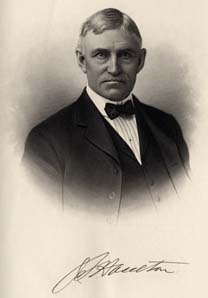Jonathan Sawyer Haselton, American manufacturer was born in Lawrence, Massachusetts, on December 5, 1847, and died in Rome, Oneida county, New York, on June 15, 1908. He was the son of Nathaniel and Myra (Sawyer) Haselton, and his earliest American paternal ancestor was Robert Haselton, who came to America from England in 1622 and settled in Massachusetts. Jonathan S. Haselton moved to Rome, New York, with his parents, when a very small boy, and obtained his education in the public schools of the city. His first venture in commercial life was as train boy on the Rome, Watertown & Ogdensburg Railroad, selling newspapers, magazines, candy, etc.
In 1866 a company was organized at Rome to build a mill for rerolling iron railroad rails. The following year the mill was erected and became known as the Rome Iron Works. Mr. Haselton immediately entered the office of the company office boy and worked his way up to clerk, bookkeeper, secretary and treasurer, and finally to the position of president, holding the latter position at the time of his death. The mill and the object for which it was erected underwent many changes. A puddling mill was added in 1871, and later a brass and a nail mill were installed. The old mill was turned into a sheet copper rolling mill in 1887 and a bathtub works added in 1891. In the latter year the name of the company was changed from Rome Iron Works to that of the Rome Brass & Copper Company, with S. O. Scudder as president and Mr. Haselton as secretary and treasurer. The practical management of the plant was delegated to Mr. Haselton, and to him its success is, in a large degree to be attributed. The Rome Factory Building Company was subsequently organized to provide a better site for factories using the products of the Rome Brass & Copper Company, and fifty acres were purchased on which there are now several factories engaged in the metal and allied industries. After the death of President W. R. Huntington, Mr. Haselton was chosen to succeed him, and the latter's son, Barton Haselton, was made secretary and treasurer to succeed his father.
Mr. Haselton was identified with the following enterprises of Rome: The Rome Metal Company, the Rome Tube Co., the Rome Electric Company, the Rome Manufacturing Company and the Long-Turney Manufacturing Company. He was also a director of the First National Bank. Despite his manifold business activities Mr. Haselton took a deep interest in the affairs of his city, and throughout his life contributed liberally to all enterprises that would result in its betterment. He donated handsomely to the Young Men's Christian Association building on West Liberty street, to the Rome Hospital and other local charities. In April, 1903, Mr. Haselton became president of the newly-formed Citizen's League & Employer's Association. In May, 1904, this body took up the matter of having that part of the Erie Canal from Black River Canal Junction to Fort Bull and through the city of Rome retained as part of the New York State Barge Canal, and later it sought to have the barge canal routed to the south of the New York Central Railroad. The league's efforts, in cooperation with a committee from the common council, were successful, and the route was finally changed to a point below the railroad. The league subsequently became the Rome Board of Trade & Employers Association.
On October 1, 1895, Mayor Kingsley appointed Mr. Haselton a water and sewer commissioner, in which capacity he served four years. In April, 1902, Mayor Caswell persuaded him to accept a similar appointment. Mr. Haselton served until 1906, when he was succeeded by his son Barton. During his term as water commissioner he rendered valuable service to the city and strongly advocated Fish Creek gravity system for the city of Rome.
Mr. Haselton was twice married, first to Miss Amelia Barton, daughter of the late Norman H. Barton of Rome, New York. Mrs. Haselton died in 1887, leaving a son, Barton, born in 1877. Mr. Haselton's second marriage was to Miss Stella Johnson, daughter of Mr. and Mrs. Samuel Johnson of Boonville, New York, who, with the son, Barton, and two daughters, Stella M. and Amelia, survives him.
